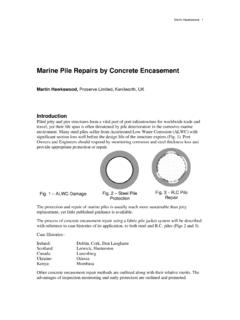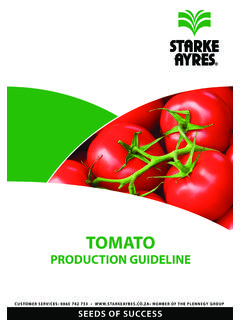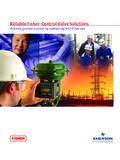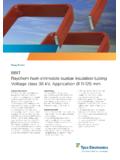Transcription of Foundations to Precast Marine Structures - …
1 Hawkswood & Allsop 1 Coasts, Marine Structures & Breakwaters 2009 Foundations to Precast Marine Structures Martin Hawkswood, Proserve Ltd, 80 Priory Road, Kenilworth, CV8 1LQ, UK William Allsop, Technical Director, HR Wallingford, Howbery Park, Wallingford, OX10 8BA, UK, 1. Introduction Precast concrete elements are increasingly used in the construction of Maritime Structures . They offer the prospect of efficient unit production and rapid construction, but that requires the efficient construction of adequate foundation restraint. Foundation design and construc-tability for these elements is therefore a critical area, but little guidance is available on the different forms of foundation available. Typical underwater foundation systems have been:- Pre-levelled Bed Stone Layers Base Infill Tremie Concrete Open Grouting Grouted Fabric Formwork (Grout Bags) Pumped sand Weak / Inadequate Strata Piled Foundations Ground Improvement This paper will describe these different foundation systems used underwater, and will describe particular experiences of combinations of systems used on completed and current projects by way of example:- Cardiff Barrage, Wales Second Severn Crossing, UK Confederation Bridge, PEI, Canada Central Artery, Boston, USA Greystones Harbour, Ireland Maritime construction is usually a high risk operation that needs efficient and suitably robust design and construction methods to be developed.
2 The relative merits of different foundation systems are also outlined in terms of design and constructability, thus seeking to inform Designers, Contractors and Owners in considering alternative and combinations of foundation systems. Figure 1 Confederation Bridge Site Hawkswood & Allsop 2 Coasts, Marine Structures & Breakwaters 2009 2. structure & Precast element types Precast concrete element solutions are often used on the following range of maritime Structures :- Harbour, quay walls and seawalls Bridge piers Breakwaters Immersed tube tunnels Barrages (particularly turbine or control sluice housings) Wind turbine mast bases Other general maritime construction Closed bottom caissons and immersed tube elements are normally floated into place taking advantage of their natural buoyancy, before being lowered into place. Open base shell caissons can be lifted in by cranes or supported by pontoons (sometimes called camels ).
3 Plain Precast blocks are typically unreinforced giving advantages of increased longevity. Due to the generally aggressive exposure conditions of maritime works, reinforced concrete elements are often formed with a combination of protected reinforcement, increased cover and corrosion resistant concrete. This is particularly so in more extreme climates. Precasting often enhances quality control, allows economic repetitive production and a reduction of in-situ Marine works to a minimum. Adequate plant and space is required within the precasting yard for casting, curing and storage. The elements can be used singularly, joined, stacked and arranged to form efficient and varied Structures / Foundations working at sea bed level. 3. Foundation Design structure Loadings Typical load types for maritime Structures Dead and imposed loads Wave momentum and impact loads, (+ve) and (-ve) Wave overtopping downfall loads Wave-driven internal and uplift pressures Current drag and lift forces Water pressures, tidal, uplift Seismic, wind loads, earth pressures, ice pressures Vessel berthing, mooring and impact Figure 3 Wave-driven Loadings1 Overtopping, q or viHorizontal force, Fh+ve Seaward force, Fh-ve Local impactpressuresInternalpressuresDownfall pressuresTypes of foundation elements often used.
4 - Solid concrete blocks Hollow concrete blocks Open topped cell caissons Open base shell caissons Immersed tubes Pier bases Mast bases Counterfort wall Other purpose made Figure 2 Quay Wall Insitu Capping Bonded Blockwork Stone Bed Hawkswood & Allsop 3 Coasts, Marine Structures & Breakwaters 2009 Foundations need to be designed to accept all realistic loads imparted from the Precast elements. This can often require design for:- Bearing pressures Overturning Sliding and slip circle failure where appropriate Settlement (overall or relative), short or longer-term deflection Scour protection Seismic and other dynamic effects (including effects of impulsive loadings) Suction pressures (from impermeable strata due to seismic / impulsive loadings). Filter failure, piping, wash out or suffusion (migration of fines). In each instance, the full range of soil / foundation / structure interactions will need to be considered in the analysis.
5 For Structures subject to significant wave or tidal action, permeable foundation layers or strata can allow transmission of wave and hydraulic pressures and be at risk of filter failure, piping, washout or suffusion. Due to the very wide range of possible Structures , foundation strata and load conditions, the above simplified list is only offered for initial guidance on foundation design and construction issues. Analysis / design procedures should be appropriate to the particular case considered, and should be in accordance with codes of practice and good practice. Foundation Strata The range of bed materials that may be encountered can be highly variable. Thorough site investigation should be carried out appropriate to the ground conditions, structure , environmental conditions and construction systems being considered2,3. Table 1 Typical Foundation Characteristics The Marine foundation characteristics for common strata shown in Table 1 are for initial guidance only.
6 Bearing Pressures for submerged granular soils are reduced due to their rela-tive density4,5. Some Precast systems may require the geotechnical assessment of relative and overall settlement during the construction period as well as the long term condition. Over-consolidated soils are far less prone to settlement. Soils with inadequate bearing capacity, or weak soil strata that are prone to high settlement, may be strengthened by ground improvement techniques or piling (see section ). Strata Type Marine Foundation Characteristics Hard Rock Often with Steps or Trenches Soft Rock Can be dressed to level/ slope Gravel to Sands Settlement is short term May erode under wave or current action unless protected Fine Sands and Silts Increasingly prone to settlement Likely to erode under wave or current action Organic Silts & Clays Highly prone to settlement and erosion Clays Unconsolidated clays particularly prone to long-term settlement Fill Strata Prone to variability, settlement and erosion Typical Allowable Bear-ing Pressures (kN/ m ) > 2,000 500 2,000 75 500 Loose Compact 50 250 Low and Variable 50 600 Low and Variable Hawkswood & Allsop 4 Coasts, Marine Structures & Breakwaters 2009 4.
7 Foundation systems and materials Pre-levelled bed, stone layer A stone layer is pre-levelled accurately on the sea bed to allow direct and rapid placement of Precast elements. The stone material is usually a crushed quarry rock with a narrow size range to allow water to flow through and avoid small particle loss6. The size range should allow it to be readily screeded accurately into place. Common screeding methods are:- Travelling Screed Hopper The frame is positioned and levelled under diver control. Aggregates are supplied via tremie tube or lowered in bottom release skips which discharge into the screed hopper by diver operation. The travelling screed hopper is then motor driven along the frame monitored by the diver. The system is gener-ally the most efficient diver operated system and usually produces good bed level control (Greystones). It is now probably the most common system for medium sized projects.
8 Screed Beam Depending upon the size and type of frame system, the screed beam can be operated by hand by the diver for small areas, by long reach excavator bucket blade, by crane lift into place and then a crane or winch operated pulley system to drag the screed beam and level the aggregate (Cardiff). A number of passes is usu-ally required. The systems are slow, diver intensive, but normally produce reasonable bed level control. They are normally used on smaller scale projects with limited repetition. Stone Tremie Tube Stone is fed down a large diameter tube whose bottom end is moved in a controlled way over the bed to be created. The bottom of the tube must be kept topped up. The system does not require diver operation and can be useful on all sizes of project. A jack up barge mounted system has recently been used for the Busan Geoje , Korea. Specialist Screeding The stone bed for the Oresund and 2nd Benelux Tunnels were laid using a specialist Scrader stone laying technique7.
9 This formed a level bed with frequent drainage trenches to accommodate the lowering exit flow and silt. The system comprises a stone tremie tube with a sliding tube foot (scrade) which self adjusts for level under surface lazer control. The tube is moved along the side of the barge whilst it is held in position with pin piles. Other mechanical and automated systems can also be used. All these systems are normally applicable to reasonably large projects. The top screeded layer of smaller stone is often laid on a foundation layer of larger stone that can act as a structural distribution layer or as a regulating layer to make up levels after exca-vation / dredging. This layer can sometimes be compacted by a vibrating plate to reduce final foundation and structure settlement. For good consistent stone layer compaction, the top sur-face may need to be installed to an overall tolerance less than the amount of surface compac-tion drop, to avoid areas of low compaction.
10 The screeded layer cannot normally be com-pacted (and achieve level tolerances). The cost to construct the screeded layer is, often some 2 times more expensive than an uncompacted foundation layer of twice its thickness. Figure 4 Traveling Screed Hopper (Khor Fakkan) Hawkswood & Allsop 5 Coasts, Marine Structures & Breakwaters 2009 Settlement Stone aggregate layers are prone to consolidation, which generally occurs during the construction and initial loading period. The settlement occurs principally within the stone layer, sometimes with secondary bedding-in settlement at top and bottom contact surfaces. Usually, shortly after construction is complete, the settlement of uncompacted stone layers is complete and in balance with the load applied. Load increases, seismic or dynamic effects can cause further settlement or deflections and should be checked5 (Fig. 5). Stone bed Foundations are often used for Quay Walls (Fig.)








